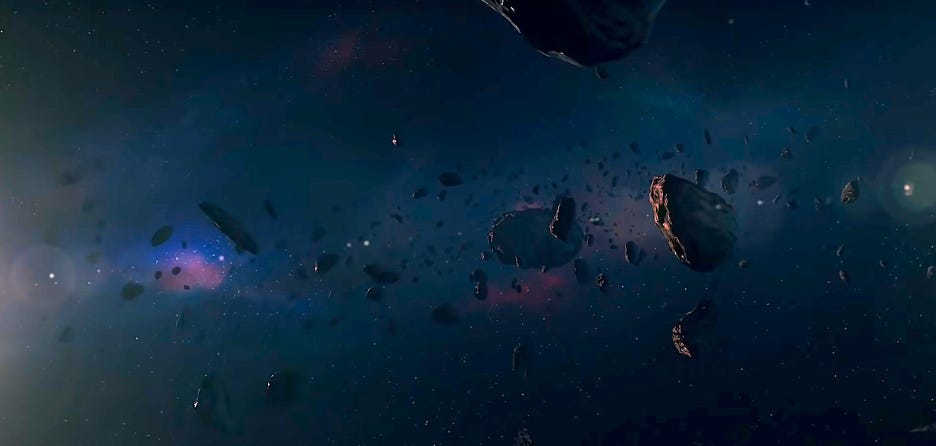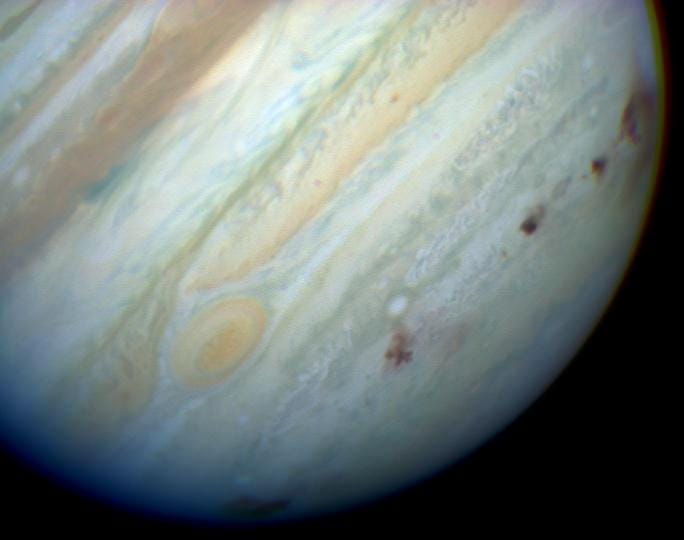Shock
What were you doing on July 16, 1994? Here are some things that happened in the months leading up to that day. You probably remember most of these events. Some may have seemed incredibly significant; a few probably seemed silly. Some may have grown in significance only in retrospect. Or not. But on a cosmic scale, none of them would even move the needle compared with the cataclysm that began on July 16.
January 1 — The North American Free Trade Agreement (NAFTA) is established.
January 17 — The 6.7 Mw Northridge earthquake strikes the Greater Los Angeles Area, leaving 57 people dead and more than 8,700 injured.
February 21 — Revealing of the first photo of Pluto and its moon Charon taken from the Hubble Space Telescope.
February 25 — Israeli Kahanist Baruch Goldstein opens fire inside the Cave of the Patriarchs in the West Bank; he kills 29 Muslims before worshippers beat him to death.
March 12 — A photo by Marmaduke Wetherell, previously touted as “proof” of the Loch Ness Monster, is confirmed to be a hoax.
April 7 — The Rwandan genocide begins in Kigali, Rwanda.
April 27 — South Africa holds its first fully multiracial elections, marking the final end of the last vestiges of apartheid. Nelson Mandela wins the elections and is sworn in as the first democratically elected president the following month.
May 6 — The Channel Tunnel, which took 15,000 workers more than seven years to complete, opens between England and France, enabling passengers to travel between the two countries in 35 minutes.
May 26 — Michael Jackson marries Lisa Marie Presley in the Dominican Republic (bet you forgot that one!)
June 17 — NFL star O. J. Simpson and his friend Al Cowlings flee from police in a white Ford Bronco. The low-speed chase ends at Simpson’s Brentwood, Los Angeles mansion, where he surrenders.
June 28 — Members of the Aum Shinrikyo cult carry out the first sarin gas attack at Matsumoto, Japan, killing eight and injuring 200.
July 8 — North Korean President Kim Il Sung dies, but officially continues to hold office.
July 16–22 — Fragments of Comet Shoemaker–Levy 9 impact the planet Jupiter.
There were 22 collisions in all. Any one of them would likely have wiped out life on Earth. We’re just lucky that Jupiter acts like a huge vacuum cleaner for space debris. In fact, without Jupiter there, life probably could not have formed on Earth in the first place.
The Scientist
I’m featuring a song that honors the late geologist and astronomer Eugene Shoemaker. He discovered or co-discovered several families of asteroids and comets, including Shoemaker-Levy 9. He showed that meteor impacts caused craters on the Earth and Moon. He ran the Geoscience program at NASA and was himself slated for an Apollo Moon mission.
He was disqualified for medical reasons, which he admitted was the greatest disappointment of his life. He eventually died in the most mundane way, in an automobile accident while on an academic research mission. Shoemaker’s ashes were taken to the Moon on a NASA probe and laid to rest in a crater named after him.
As far as we know, he is the only person to date interred on another planetary body. The capsule holding his ashes is inscribed with a passage from Romeo and Juliet, which you will hear in the voice-over in this song.
Beauty
There is no modern genre of music more closely related to Western Classical music than heavy metal. They both involve intricate composition, with multiple musical ideas in one piece, roller-coaster emotional journeys, and a high bar for instrumental virtuosity. Unfortunately, quite early in its history, the world of metal plunged into an arms race of darkness, doom, and screaming, which consigned much of it to fringe status in the world of popular music.
It needn’t be this way, and in fact, there is a movement, mostly in Europe and more recently in Japan, focused on making metal beautiful. At the heart of this movement is something often called “symphonic rock.” One of its defining features is that most musicians are classically trained, and their compositions reflect that.
Another is the prominent role of women. Where metal was once the exclusive domain of angry-sounding young men, a new wave of artists are infusing it with divine feminine energy. They have been at it since the mid-1990s, but hardly anyone in America knows it. That is unfortunate because they are making some of the most glorious music since the heyday of Beethoven and Chopin.
Nightwish are widely regarded as one of the avatars of symphonic rock. (I have posted extensively about them before.) They were founded in 1997 and have featured three remarkable lead vocalists. This song features the third, and in my humble opinion, the greatest of the three, Dutch soprano Floor Jansen.
Awe
My hat is off to Nightwish for celebrating a scientist. It happens too seldom and seems especially apt at a time when many of our political leaders are waging war on science. If you are unfamiliar with Nightwish or Jansen, I urge you to listen and play it all the way through — the ending is truly stunning. I’ve seen them perform it live, bringing a crowd of hardened metalheads to tears.
Note: “Human :||: Nature” was my pick for 2020 Album of the Year, and I consider this song the album's highlight. The entire album has been uploaded to YouTube and is available on streaming services in case you want to hear more.





